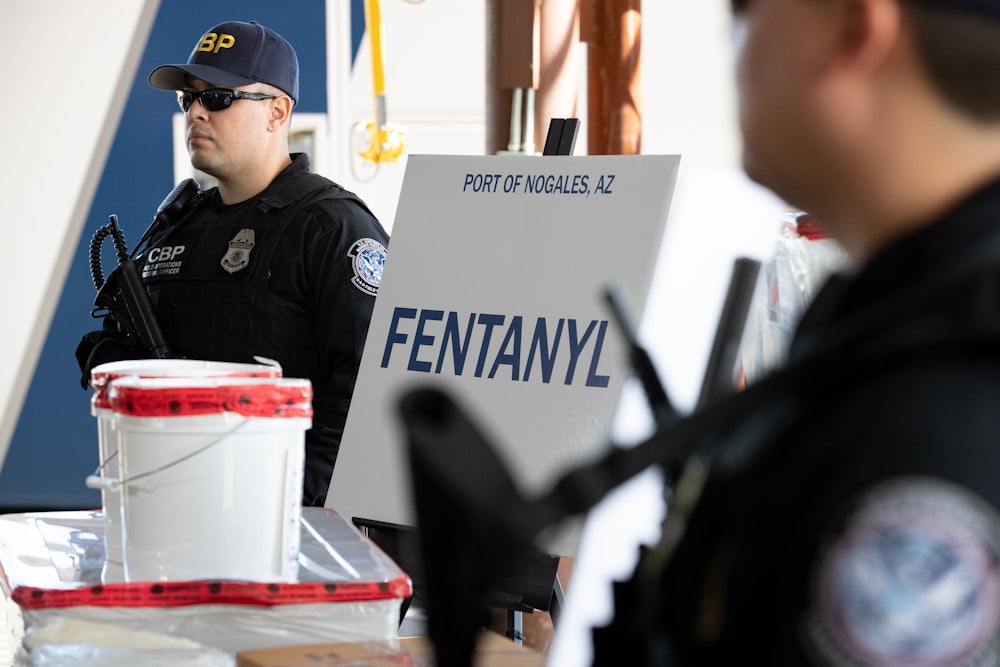On September 6, Senator Joni Ernst tweeted that “enough fentanyl to completely wipeout entire cities in the U.S. has been seized at the southern border.” The Iowa Republican’s statement echoes recent claims from federal and local law enforcement agencies that seizures of the potent synthetic opioid prevent thousands—or even millions—of deaths. On August 5, Newsweek cited a U.S. Customs and Border Protection press release, and reported that “a shipment heading through the U.S. that contained enough fentanyl to kill just over 50,000 individuals was recently seized by officials.”
With more than 70,000 fentanyl-related overdose deaths per year—and an overdose crisis that is contributing to a historic decline in life expectancy in the U.S.—politicians and law enforcement are reverting to a long discredited drug war tactic: displaying drug seizures to the public and making highly exaggerated claims about what the busts mean to the illicit drug supply and public health.
This summer, the Orange County District Attorney’s office in California claimed that one seizure of roughly 24 kilograms of fentanyl powder and pills was “enough fentanyl to kill 12 million people.” But the number of people who use illicit fentanyl in the U.S. is nowhere close to 12 million. While there’s no reliable data on the total number of fentanyl users, estimates show there are roughly three million people living with an opioid use disorder, only a portion of whom use street fentanyl. And a 2019 RAND Corporation study noted that the spread of fentanyl and synthetic opioids “differs fundamentally from past drug epidemics” because these drugs increase deaths while not necessarily expanding the number of users.
“It is like seizing a cache of 10,000 bullets from a criminal’s arsenal and saying there was enough ammo to kill everyone in town,” said Brandon del Pozo, a health and medicine professor at Brown University and former police chief of Burlington, Vermont. But those who are at risk of fatally overdosing are mainly those who purchase illicit drugs.
“These lethal dose counts really overestimate the number of deaths in a way that is not helpful,” said Bryce Pardo, an associate director of the Drug Policy Research Center and a policy researcher at RAND. The problem is these busts are reported purely in terms of weight, with little nuance as to what exactly they’ve seized. By exaggerating the lethality of drug seizures, law enforcement is scaring the public instead of informing them; research shows that such messages could backfire and draw people to use drugs in more risky ways. According to Pardo, the purity of fentanyl is far more significant than the weight of a seizure. Fentanyl tablets are typically 1 to 2 percent pure, while bulk fentanyl powder seized at the southern border is about 10 percent pure, according to Pardo’s analysis of DEA seizures. “There’s some really low purity,” he said. “They’re really moving dead weight.”
Jonathan Caulkins, a drug policy researcher at Carnegie Mellon University, stressed that even successful supply-side drug enforcement is limited in making a dent in drug epidemics. “It is next to impossible to shut down the supply of an established drug,” Caulkins said. “And fentanyl is harder than most.” Unlike cocaine and heroin, which require farmers cultivating acres of land in the right climate, fentanyl is purely synthetic and can be made in a lab anywhere. Traffickers can quickly manufacture a new batch of fentanyl to replace whatever product was confiscated by authorities, Caulkins explained. “Seizures still have some effect on the supply,” Caulkins said. “Supply controls just have their limits.”
Dan Ciccarone, a physician-researcher at the University of California–San Francisco who studies America’s drug supply, echoes Caulkins’s sentiments on supply enforcement. “I think taking fentanyl off the street is a good idea,” he said. “But I also recognize that it’s mostly folly. There’s so much supply it’s kind of mind-blowing.” Ciccarone said that if drug seizures were having the effect claimed by authorities, then prices would rise as availability shrinks. But the drug supply is so vast that prices stay low and users maintain easy access despite seizures, Ciccarone said.
Noah Hurowitz, author of El Chapo: The Untold Story of the World’s Most Infamous Drug Lord, compared drug enforcement to a deadly game of whack-a-mole. “Seizures on the border tend to foster violence on the border,” he said. “The flip side to Americans dying from fentanyl overdoses are people in Mexico dying from violence.”
Facing an unprecedented public health crisis, law enforcement is under enormous pressure to demonstrate to the public that its efforts are making a difference. That’s where flashy press conferences showing off piles of cash, drugs, and guns come into play: a P.R. strategy for America’s drug war amplified by eager news outlets. The drug trade’s complexity is flattened, and law enforcement’s thinking—that drug seizures will prevent overdose deaths—goes unchallenged.
Drug weights are the building blocks of the drug war at both the state and federal level. As the drug war ramped up during the 1970s and 1980s, drug quantity and weight were conceived as an objective indicator of a person’s involvement in the drug trade. Larger quantities resulted in stiffer penalties. In New York state, for example, criminal statutes for drug sales and possession are largely defined by the weights of drugs like ketamine, LSD, and cocaine. The current focus on fentanyl weights repeats this foundational mistake. “When they pile more dope and arrests on the table, it is proof positive that they are losing,” The Wire creator David Simon tweeted in 2020. “What they can seize or lock up is always a clean ratio of how much product and how many players are saturating the market. End the fucking drug war. The drugs have won.”
It’s a viewpoint not shared solely by anti–drug war prestige TV showrunners. In a historic decision 10 years ago concerning a man facing a steep federal prison sentence for selling crack to an informant “for a total gain to himself of $140,” federal judge John Gleeson lambasted Congress for what he said was a fundamental error in the 1980s when it established severe sentences “triggered not by role” in a drug organization “but by drug type and quantity instead.” Drug quantity, Gleeson wrote, “is a poor proxy for culpability generally and for a defendant’s role in a drug business in particular.”
This weight-centric approach to drug epidemics led to the notorious 100-to-1 disparity between sentences for crack and powder cocaine–related offenses. In 2010, Congress passed the Fair Sentencing Act, which reduced the crack-to-powder disparity to 18-to-1. “What we did with crack cocaine was a travesty of justice that harmed a lot of people’s lives,” said Regina LaBelle, a professor at Georgetown University who served a stint as President Biden’s acting drug policy director. “We shouldn’t emulate that today.” Thanks in part to the unraveling of excessive punishments tied to drug weights, the population of federal prisoners serving time for drug crimes began a modest decline in 2014, after sentencing reforms. By 2018, the number of people in state prisons for drug offenses fell by 36 percent from its peak in 2007. Still, the number of people incarcerated for drug crimes—374,000 people on any given day—remains much higher than in 1980, when the drug war escalated.
That trend could slow down with states increasing fentanyl-related penalties and pursuing overdose cases as homicides. In May, Florida increased the mandatory minimum sentence for trafficking fentanyl from three years to seven years for anyone caught with four to 14 grams of the drug; those caught with 14 to 28 grams now face a 15- to 20-year mandatory sentence. Colorado recently made possession of just one gram of fentanyl a felony. And a man in Plaquemines Parish, Louisiana, was sentenced this month to 20 years in prison for the 2021 overdose death of a high school senior.
“Lawmakers could cause a lot of harm by sentencing a lot of people for a long period of time,” Pardo said. “[They] don’t fully understand or appreciate the potency and purity factors involved with synthetic opioids.”
Nabarun Dasgupta, a scientist who studies drugs at the University of North Carolina, analyzes the composition of street drugs—which are often cut with everything from obscure chemicals to common painkillers—and publishes that information to help users be aware of what they’re consuming. “That’s the big missing piece from these DEA alerts,” Dasgupta said. “We don’t have a sense of what the health harms are. All we get is panic. We would love to know what these substances are cut with that could be causing lung problems.” Dasgupta said law enforcement authorities rarely communicate pertinent information to the public, such as where to find naloxone, and warns that “if you don’t pair an action with the alert, you’re wasting an opportunity to redirect that uproar into prevention.”
Pardo of RAND said that law enforcement would have to reimagine how it views public health and safety, because its traditional tactics—“removing dope from the street and arresting people”—have improved neither public health nor safety. “You’re plowing the ocean at that point.”
This story was produced in partnership with the Garrison Project, an independent, nonpartisan organization addressing the crisis of mass incarceration and policing.


